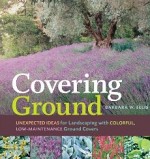 You may think of ground covers being plants of last resort for planting in waste areas where nothing else will grow but that is not necessarily the case. Author, Barbara W. Ellis, shows you that ground covers can be exciting and beautiful as well as useful. She also points out that a well chosen ground cover requires less water and fewer pesticides, fertilizers and other chemicals. By following the suggestions offered by Ellis, you can create a landscape the looks good, requires less maintenance, and is environmentally friendly.
You may think of ground covers being plants of last resort for planting in waste areas where nothing else will grow but that is not necessarily the case. Author, Barbara W. Ellis, shows you that ground covers can be exciting and beautiful as well as useful. She also points out that a well chosen ground cover requires less water and fewer pesticides, fertilizers and other chemicals. By following the suggestions offered by Ellis, you can create a landscape the looks good, requires less maintenance, and is environmentally friendly.
The book is divided into three sections. The first deals with the many roles ground covers can play and introduces the reader to many plants that can be used as ground covers. The importance of analyzing the site and choosing the right plants are discussed and possible options for the use of hardscape to enhance the site are suggested. Insets provide additional information on topics such as invasive ground covers to avoid, adding color with bulbs, and the use of annuals as temporary fillers.
The second section focuses on plant selection. Ground cover plants are listed alphabetically by usefulness; active spreaders, well behaved sun lovers, ground huggers for paths and stepping-stones, small-scale spreaders, bold perennials for sun, plants for a sunny slope, vines, shrubs, perennial shade lovers, native plants for a woodland, moisture-loving plants, and acid soil-loving plants. Entries include a description, cultural information, suggestions for plant combinations and pictures.
The final section addresses the planting, growing, and propagation of ground covers. The author emphasizes the importance of preparing the site properly especially the elimination of weeds, and continues with suggestions for buying and installing plants, including the special problems presented by planting on a slope. Maintaining and renovating ground covers are discussed and various methods of reproducing ground covers are described.
The biggest asset of this book is helping the reader to look at ground covers in a new way. Instead of growing a single tough plant the author shows what can be done by using a broad palette of plants and creating harmonious plant combinations. Plants you never thought of as ground covers can be used to perform all the tasks of the old standbys but are far more attractive and vibrant. The numerous photographs alone provide enough ideas to justify the price of the book and may tempt you to turn lawn into ground cover just to get “the look”. A good read and valuable reference.
To buy Covering Ground from Amazon.com click here.